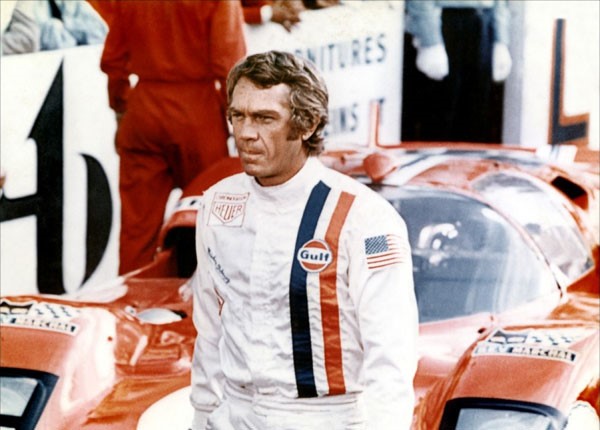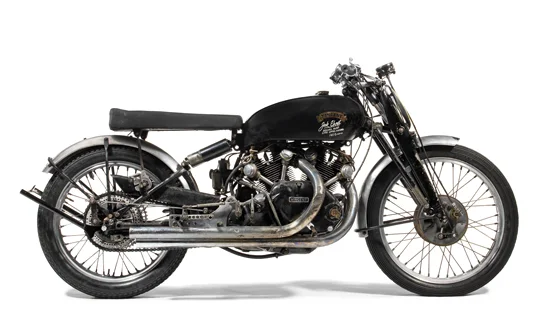The Las Vegas Bonhams auction shows that the classic bike market is healthier than ever, at a time when classic car prices have rightly flattened off.
The Bonhams motorcycle auction in Las Vegas yesterday brought together an excellent collection of vintage and collectible motorcycles. This sale was a typical collection for Bonhams in that most of the bikes on offer were serious collector’s items. The sale went on for a few hours with, basically, business as usual – and then the original condition, Australian speed record-setting, 1951 Vincent Black Lightning motorcycle hit the block.
Bidding started at around $400,000 (R4,4 million SA Rand) and just kept going. The sale for this bike finally hammered sold at an unbelievable $929,000(R10,3 million SA Rand), which makes it the most valuable motorcycle ever sold at auction.
The bike was built as a special order and imported new into Australia by Tony McAlpine. The Vincent Black Lightning, number 7305, is one of just approximately 30 Black Lightning models built by the Stevenage, England factory.
At the time when it was built, another well-known Vincent, nicknamed 'Gunga Din', was undergoing work in the factory as well and was prepped to smash speed records. After both were completed, the two machines were raced at an airfield where it is said that McAlpine's bike was a clear 30 yards ahead of Gunga Din, and factory records indicated that it achieved speeds in excess of 130mph in third gear.
The story gets better though, in that in 1953 the McAlpine-ordered motorcycle smashed the existing Australian speed record when Jack Ehret rode it to an average speed of 141.5mph.
'Rollie Free and Marty Dickerson [legendary Vincent riders], knew of this motorcycle and Ehret's acclaim,' according to Ben Walker, Bonhams head of motorcycling. 'After the "Bathing Suit Bike" ridden by Free, the Ehret bike is likely the most important Black Lightning in existence and is one of the world's most desirable machines.'
This piece of history is the most important motorcycle seen offered at a US motorcycle sale and speaks to a market that is ready and willing to step up and pay whatever it costs to acquire important and significant motorcycles.
The rest of the sale also saw some very strong numbers, especially with the other Vincent’s and Bough Superiors on offer. These included the all-original two-owner 1950 Vincent Comet selling for $33,925(R375000 SA Rands), the 1953 Vincent Black Shadow Series C selling for $88,550R975000 SA Rands), the 1955 Vincent Black Prince selling at $104,650(R1,1 million SA Rand), and the 1939 Brough Superior SS80 (above) that sold for $120,500(R1,4 million SA Rand).
Some of the Italian motorcycles did not fare as well as the British counterparts. A pair of MV Agustas, a 1975 750 America (above) and a 1977 850SS were no sales, as were the 1985 Ducati-NCR 850 Pro twin, which had a pre-auction estimate of $80,000 to $100,000R880000-R1, million SA Rand), and the 1987 Ducati 750F1 Laguna Seca, which had only a $23,000 to $26,000(R250000-R325000 SA Rand) pre-auction estimate.
On the Japanese bike front, a huge winner was the 1990 Honda VRR750R RC 30 that sold for what could be a record $92,000(R1,1 million SA Rand), or basically R130k more than the Vincent Black Shadow. The best buy for Japanese bikes was, for me, the competitor in period to the RC 30, the 1991 Yamaha FZR 750RT OW01 (below) that was bought extremely well for $34,500(R375000 SA Rand).
Despite all of this serious heavy metal selling at strong prices, Bonhams also brought a number of entry-level collector bikes to their sale. The standouts of these were the 1975 BMW R75/6 that was a strong buy at only R40000-00 the 1970 Norton Commando 750S café racer for a bargain R60000-00 the stunning Jacaranda Purple over Silver Sheen 1970 Triumph T100C (below) that sold for R100K.
This year looks like it could be a banner year for classic motorcycles, and being a collector of these bikes myself I think that it is about time.






























































